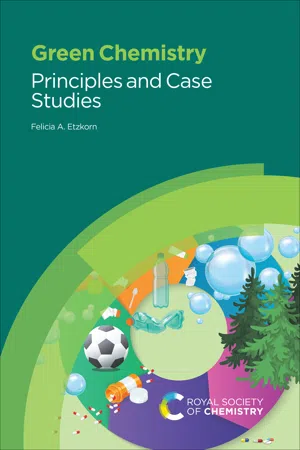![]()
Contents
1 Prevent Waste
1.1 Green Chemistry: First, Do No Harm
1.2 Better Living Through Chemistry
1.3 Environmental Pollution
1.4 Risk Is a Function of Hazard and Exposure
1.5 Toxicology and Environmental Chemistry
1.6 Life Cycle Analysis
1.7 Case Study: Polylactic Acid (PLA) (NatureWorks®)
1.8 Resources: The Scientific Literature
1.9 Implementation of Green Chemistry
1.10 Summary
1.11 Problems: Prevent Waste
References
2 Synthetic Efficiency
2.1 Intermediates and Reagents
2.2 Calculating Efficiency
2.3 Case Study: Atom Economical Ibuprofen Process (BHC Company)
2.4 Chirality
2.5 Greener Solutions for Single Stereoisomers
2.6 Case Study: Synthesis of Tamiflu from Shikimic Acid (Nie et al.)
2.7 Multistep Synthetic Efficiency
2.8 Summary
2.9 Problems: Synthetic Efficiency
References
3 Benign Synthesis
3.1 Eliminating Toxins in Synthesis
3.2 Regulatory Frameworks
3.3 Toxicology
3.4 Classifications of Chemical Toxins
3.5 Case Study: Greener Quantum Dot Synthesis (QD Vision)
3.6 Redox Reactions
3.7 Case Study: Fe-tetra-amido Macrocyclic Ligand (TAML™) Oxidation (Collins)
3.8 Case Study: Alcohol Oxidation by O2 with Cu/TEMPO (Stahl)
3.9 Case Study: Amide Reductions with Silanes and Fe Catalysts (Nagashima)
3.10 Summary
3.11 Problems: Benign Synthesis
Bibliography
References
4 Benign Products
4.1 Benign by Design
4.2 Cradle-to-Cradle
4.3 Toxicology for Products
4.4 Causation
4.5 Regulations
4.6 Methods for Avoiding Toxic Substances in Products
4.7 Persistent Organic Pollutants (POPs)
4.8 Endocrine Disrupters
4.9 Pesticides
4.10 Case Study: Spinosad and Natular (Clarke)
4.11 Toxic Heavy Metals
4.12 Case Study: Yttrium as a Lead Substitute in Electrodeposition (PPG Industries)
4.13 Summary
4.14 Problems: Benign Products
Bibliography
References
5 Avoid Auxiliaries
5.1 Auxiliaries Defined
5.2 Solvent Auxiliaries
5.3 Extraction Auxiliaries
5.4 Chromatography Auxiliaries
5.5 Minimize Auxiliary Substances
5.6 Solvent-free Synthesis
5.7 Case Study: A Solvent-free Biocatalytic Process for Cosmetic and Personal Care Ingredients (Eastman Chemical Co.)
5.8 Selecting Conventional Solvents
5.9 Greener Substitutes for Solvents
5.10 Case Study: Water-based Acrylic-alkyd Technology (Sherwin-Williams Co.)
5.11 Case Study: Hydrogenation of Isophorone in scCO2 (Nottingham-Swan)
5.12 Summary
5.13 Problems: Avoid Auxiliaries
References
6 Energy Efficiency
6.1 Energy
6.2 Conservation of Energy
6.3 Case Study: Succinic Acid Through Metabolic Engineering (BioAmber)
6.4 Microwaves
6.5 Case Study: Cellulose Processing by Microwave with an Ionic Liquid (Rogers)
6.6 Photochemistry
6.7 Case Study: Ruthenium Photocatalyst (Yoon)
6.8 Battery Technology
6.9 Case Study: Vanadium Redox Flow Battery (UniEnergy Technologies)
6.10 Transformer Technology
6.11 Case Study: Vegetable Oil Dielectric Insulating Fluid for High Voltage Transformers (Cargill)
6.12 Renewable Liquid Fuels
6.13 Solar Photovoltaics
6.14 Summary
6.15 Problems: Energy Efficiency
References
7 Renewable Feedstocks
7.1 Fossil Feedstocks
7.2 Renewable Feedstocks
7.3 Cellulose
7.4 Sugars
7.5 Case Study: Cost-advantaged Production of Intermediate and Basic Chemicals from Renewable Feedstocks (Genomatica)
7.6 Lignins
7.7 Nitrogen: Proteins, Amino Acids, and Nucleic Acids
7.8 Case Study: Production of Biofeedstock Dicarboxylic Acids for Nylon (Verdezyne)
7.9 Case Study: Human Immunodeficiency Virus (HIV) Drug Carbovir from a Purine
7.10 Lipids: Fats and Oils
7.11 Natural Products
7.12 Case Study: Synthesis of Paclitaxel from Pacific Yew Tree Needles
7.13 Summary
7.14 Problems: Renewable Feedstocks
References
8 Avoid Protecting Groups
8.1 Derivatives
8.2 Renewable Feedstocks
8.3 Reactive Functional Groups
8.4 Case Study: Convergent Synthesis of an α-Hydroxyamide (Etzkorn)
8.5 Case Study: An Efficient Biocatalytic Process for Simvastatin Manufacture (Codexis-Tang)
8.6 Protecting-group-free Synthesis
8.7 Case Study: Synthesis of Ambiguine H Without Protecting Groups (Baran)
8.8 Convergent Synthesis
8.9 Case Study: Convergent Synthesis of Swinholide A (Krische)
8.10 Summary
8.11 Problems: Avoid Protecting Groups
References
9 Catalysis
9.1 Catalysts Accelerate Reactions
9.2 Enzymes: Nature's Catalysts Are Proteins
9.3 Advantages of Catalysts
9.4 Case Study: Greener Manufacturing of Sitagliptin Enabled by an Evolved Transaminase (Merck–Codexis)
9.5 Earth-abundant Metal Catalysts
9.6 Catalytic Mechanisms
9.7 Case Study: Using Metathesis Catalysis to Produce High-performing, Green Specialty Chemicals at Advantageous Costs (Elevance)
9.8 Catalyst Reuseability
9.9 Summary
9.10 Problems: Catalysis
References
10 Degradation or Recovery
10.1 Biological and Industrial Cycles
10.2 Case Study: Biodegradable Polymers from Carbon Monoxide (Coates)
10.3 The Great Pacific Garbage Patch
10.4 Case Study: Water-degradable Plastics (Miller)
10.5 Case Study: Bacterial Degradation of Polyethylene Terephthalate (Miyamoto-Oda)
10.6 Case Study: Biodegradable Surfactants and Sugars Replace Very Persistent Fluorinated Surfactants in Aqueous Firefighting Foams (Solberg Co.)
10.7 Metals Recovery
10.8 Case Study: Recovery of Ecocatalysts from Plants (Grison)
10.9 Summary
10.10 Problems: Degradation or Recovery
References
11 Real-time Analysis
11.1 Real-time Analysis
11.2 Control Parameters
11.3 Reaction Monitoring
11.4 Case Study: Highly Reactive Polyisobutylene (Soltex)
11.5 Spectral Methods
11.6 Case Study: 3D TRASAR® Cooling System Chemistry and Control (Nalco)
11.7 Chromatographic Methods
11.8 Reactor Design
11.9 Case Study: Kilogram-scale Prexasertib Monolactate Monohydrate Synthesis Under Continuous Flow CGMP Conditions (Ely-Lilly & Co.)
11.10 Summary
11.11 Problems: Real-time Analysis
References
12 Prevent Accidents
12.1 Eliminate Hazards
12.2 Types of Chemical Hazards
12.3 Global Harmonization System
12.4 Elimin...
